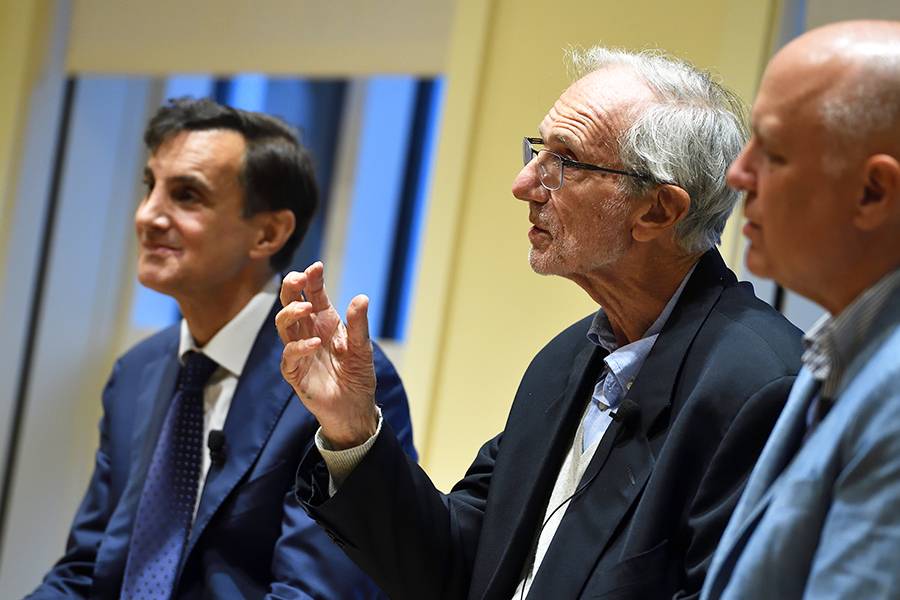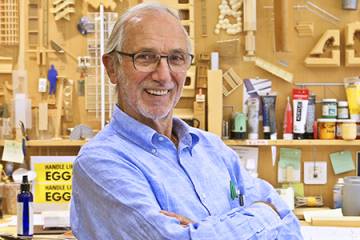World-renowned architect Renzo Piano says principles of openness, accessibility, and harmony with nature will guide him on his newest design project: the Stavros Niarchos Foundation Agora Institute building at Johns Hopkins University's Homewood campus.
After spending the day getting an intimate sense of the campus, Piano—the visionary behind such emblematic sites as the Georges Pompidou Center in Paris, the Shard in London, the Stavros Niarchos Foundation Cultural Center in Athens, and the new Whitney Museum of American Art in New York—sat down Monday evening for a conversation about his design vision and philosophy with JHU President Ronald J. Daniels in front of a capacity crowd at Mason Hall.
Piano, 81, described his craft as one that reflects and responds to societal change.
"The architect, in some way, gives built shape to that change," Piano said. "You celebrate that change."
Because humans are naturally resistant to change, Piano added, new architecture can be controversial by its nature, referring to some of the initial reactions to the radical design for the Pompidou Center, built in Paris in 1977.
"Changes are never easy to swallow. Changes are making trouble," he said. "If architecture is a mirror to that change, we can't expect that to be approved immediately by everybody."
Johns Hopkins announced last week that the Renzo Piano Building Workshop firm would lead the SNF Agora Institute project, designing a 38,000-square-foot interdisciplinary center devoted to strengthening the ideals of democracy through civic engagement and discourse.
The acclaimed Italian architect shared some early thoughts on the endeavor, noting that every one his projects begins with understanding and listening to the surrounding place.
"The places talk—they always say something," he said. "But you have to shut up and you have to listen."
Video credit: Johns Hopkins University
For the SNF Agora Institute project, Piano said it is "essential" for him to "look at the faces of young people" around campus, and also to understand the neighborhood and "the relationship between the city and the university."
Longtime Renzo Piano Building Workshop partner Mark Carroll, who joined Piano at Monday's event, said the natural landscape of the Homewood campus "will help generate the shape of the building.
"I think one of the great things [in] the DNA of this area is nature," Caroll said, noting "the incredible landscape, trees and vegetation, that is everywhere on this campus."
The SNF Agora Institute, launched in 2017 with a $150 million gift from the Stavros Niarchos Foundation, will be both an academic and public forum, drawing inspiration from the Agora of ancient Athens and bringing together a diverse range of experts to enhance civic discourse across the globe.
The new institute building—to be built at a not-yet-determined Homewood campus location—will house a director, 10 faculty members, 10 visiting scholars, and both graduate and undergraduate students. It will also host a variety of public events, including an annual conference on public policy issues, lectures, and performances.
Daniels announced Monday that local architecture firm Ayers Saint Gross will partner with Piano's team on the project.
Piano said he sees the SNF Agora Institute's role as responding to "the big shift [of] globalization … in a world where we need to make bridges."
In thinking about this role of connectivity, the architect said, a persistent question is "How can you be local and universal at the same time?"
The new building, he said, will be "talking to the rest of the world, and talking to the community."
Daniels asked the architect about his response to the retrospective of his life's work that recently opened at the Royal Academy of Arts in London. The exhibit includes a sculptural installation replicating in miniature 100 of Piano's buildings from across the globe.
"The most important emotion was surprise," Piano said of his visit to the Royal Academy last week. As with any artist looking at the breadth of his or her work, he said, "you spend your life being surprised at what you can do."
Posted in Arts+Culture, Politics+Society
Tagged architecture, snf agora institute










